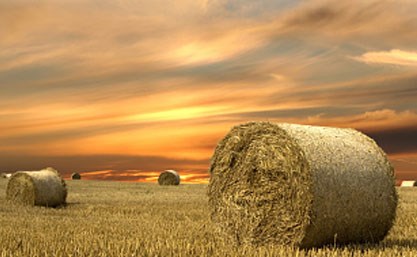As land prices are climbing and forage acres are dwindling due to flooding or alternative land uses, producers place higher expectations on the productivity of their hay stands. A high quality forage stand starts with a seed blend matched to the environmental conditions as well as the end-use goal of the hay to be produced. Establishing and maintaining a high percentage of legumes like alfalfa in a hay stand allows the production of high protein hay and reduced nitrogen fertility requirements. Just as important as choosing the right seed blend is the implementation of a strong fertility program at the time of seeding and during the stand production span.
The importance of providing sufficient fertility to a hay stand becomes apparent when considering the quantities of nutrients exported with each hay crop removal. A grass stand producing an annual yield of 3 tons per acre equals the removal of 90-120lbs of N, 25-35lbs of P2O5, 120-140lbs of K2O, and 10-15lbs of S. Harvesting a 5 tons per acre alfalfa hay crop is equivalent to removing 260-320lbs of N, 60-80lbs of P2O5, 270-330lbs of K20, and 25-35lbs of S. The good news is that a hay stand consisting of more than 50% legumes can provide sufficient nitrogen fixation to replace the nitrogen removed in each harvest. This is given that the legumes are properly inoculated and that the proportion of legumes can be maintained over the age of the stand.
Even though existing stands can be fertilized or legumes added to pure grass stands, the most economical fertilization program focuses on providing sufficient and balanced fertility at the time of seeding. Most forage stands in Saskatchewan are underfertilized and are expected to respond positively to fertility. The actual amount of fertilizer to be applied is best determined through a soil test prior to seeding. Each soil will be different based on parent material and cropping history. A stand with 60-70% of legume content may need around 50lbs of actual P, 30lbs of actual K and 10lbs of S. Keep in mind that no more than 15lbs of actual P can be seed placed. Consider banding or top-dressing larger amounts of fertilizer to avoid damaging the forage seed.
Even if they are well fertilized at establishment, productivity of hay stands will gradually decline over time. For example, a hay stand in the black soil zone containing about 60-70% of legumes and fertilized at establishment could produce around 2 tons per acre in its third year of production. If left unfertilized, the stand productivity is expected to decline to about 1.25 tons per acre per year. The addition of another 50lbs of actual P, 30lbs of actual K and 10lbs of S would be expected to help maintain the current production levels of 2 tons per acre per year for another three years. Please keep in mind that this scenario is used as an example and that actual amounts of fertilizer should always be based on a soil test.
Where pure grass stands are fertilized, the main focus will be on the addition of nitrogen. The expected yield response of grass stands to the addition of nitrogen depends on soil zone and moisture conditions in the year of application. In the dark-brown soil zone it is expected that for each pound of nitrogen applied, dry matter yield increases between 15 to 25lbs. In the black soil zone, each pound of nitrogen is expected to increase dry matter yield by about 20 to 30lbs. Nitrogen fertilizer does not just increase the yield of a grass stand but also boost the protein content of the grass.
Please keep in mind that fertilizer responses always depend on species present, soil type, and moisture conditions. Fertilizer is only one piece to the puzzle of a healthy stand and is not a substitute for good management.
For more information:
• Contact your local Regional Forage Specialist; or
• Call the Agriculture Knowledge Centre at 1-866-457-2377
Regional Forage Specialist, Watrous Regional Services Branch



